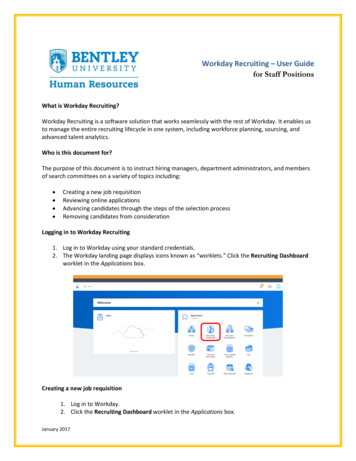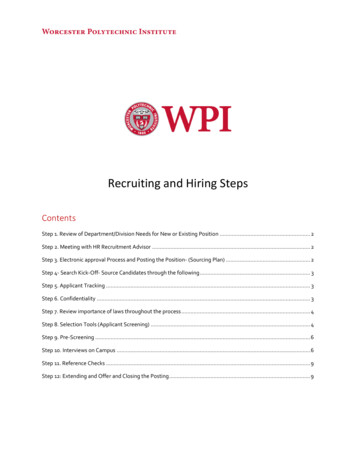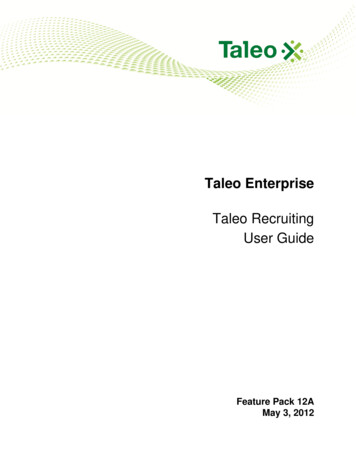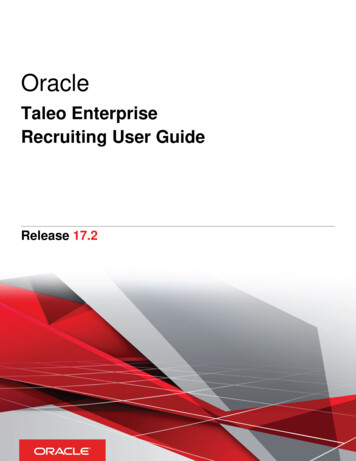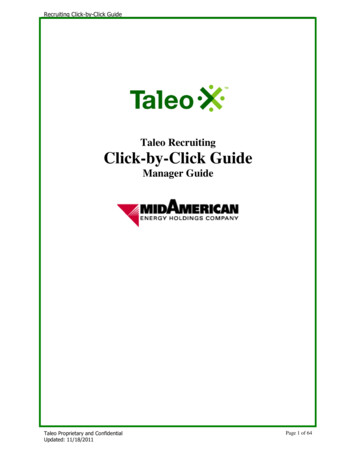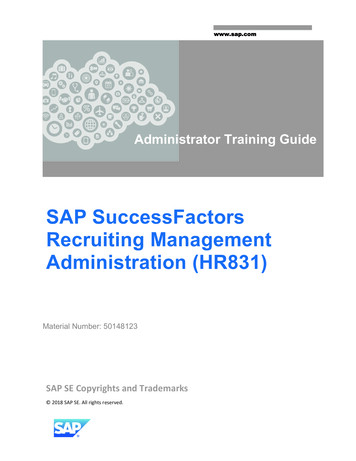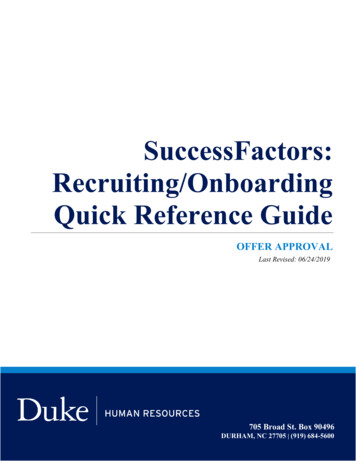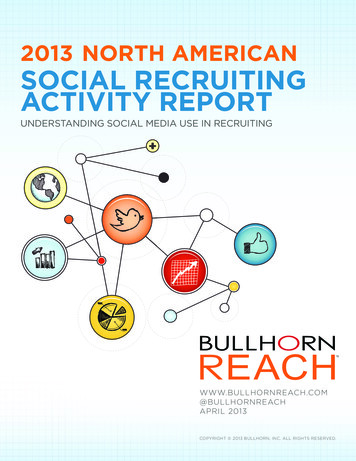
Transcription
2013 NORTH AMERICANSOCIAL RECRUITINGACTIVITY REPORTUNDERSTANDING SOCIAL MEDIA USE IN IL 2013COPYRIGHT 2013 BULLHORN, INC. ALL RIGHTS RESERVED.2013 NORTH AMERICAN SOCIAL RECRUITING ACTIVITY REPORT1
This report examines the social media activity of North Americanrecruiters across the “big three” social networks — LinkedIn,Facebook, and Twitter. In this report, we present key findings andbenchmark data culled from the actual activities of more than 160,000recruiters in the Bullhorn Reach user network in 2012.LIST OF FIGURES24FIGURE 1.0: Network Combinations and Networks Connected5FIGURE 2.0: Network Adoption6FIGURE 3.0: Average LinkedIn Network Size7FIGURE 4.0: Average Facebook Network Size8FIGURE 5.0: Average Twitter Network Size9FIGURE 6.0: Network Size Distribution Among Recruiters10FIGURE 7.0: Relative Comparison of Views per Job Posting by Network11FIGURE 8.0: Relative Comparison of Applications per Job Posting by Network12FIGURE 9.0: Relative Comparison of Applications per Contact by Network13FIGURE 10.0: Average Applications per Job Post by Network Size14FIGURE 11.0: Social Recruiting Use by Industry Vertical2013 NORTH AMERICAN SOCIAL RECRUITING ACTIVITY REPORT
INTRODUCTIONWith 98% of recruiters1 leveragingcandidates via social media,” thesocial media in 2012, and the greatestpotential payoff for taking advantageopportunity for the staffing industryof LinkedIn, Facebook, and Twitter forin 2013 being “access to passiverecruiting has never been stronger.KEY TAKEAWAYS Early adopters of social recruiting use a wider variety of social media than later adopters.While the percentage of recruiters using Facebook and Twitter has gone down from 2011 to 2012,the percentage of early adopters from 2011 using these networks has gone up. Recruiters are relying heavily on LinkedIn, because its value is clear. 64% of recruiters usedonly LinkedIn for social recruiting in 2012, compared to 48% in 2011, and with good reason. Jobsposted on LinkedIn received more views than jobs posted on Twitter and Facebook put together. Recruiters are under-utilizing Twitter and Facebook. Only 12% of recruiters were connectedto all three social networks — LinkedIn, Facebook, and Twitter — in 2012. Half of North Americanrecruiters using Twitter for recruiting have fewer than 50 followers. Facebook isn’t a highly-utilized social recruiting tool because it isn’t popular amongrecruiters — not because it doesn’t work. Facebook is the largest social network on the planet,but only 22% of recruiters used Facebook for recruiting in 2012, versus 27% who used Twitter.However, 16.7% of recruiters successfully used Facebook to place candidates versus just 12.7%with Twitter.1Bullhorn 2013 North American Staffing and Recruiting Trends Report: http://sites.bullhorn.com/NATrendsSurvey/2013 NORTH AMERICAN SOCIAL RECRUITING ACTIVITY REPORT3
RECRUITERS AREN’T MAKING THE MOSTOF SOCIAL RECRUITINGSocial Networks Connected100%97%90%80%64%14%8%12%2% cebookfigure 1.0Note: The chart above represents recruiters who have connected their Bullhorn Reach accounts to at least one social network.Recruiters were more reliant on LinkedIn in 2012 than in 2011. Of all Bullhorn Reach recruiterswho used one or more social networks for recruiting in 2012, 97% used LinkedIn. Twitter wasa distant second at 27%, with Facebook last. With 97.3% of recruiters reporting that they usedLinkedIn in our 2013 North American Staffing and Recruiting Trends Report2, the Bullhorn Reachand anonymous North American findings closely align.Only 12% of recruiters were connected to all three social networks — LinkedIn, Facebook, andTwitter — in 2012. This is a sizeable decrease in percentage from 2011, when 21% of recruiterswere using all three networks.While 48% of recruiters relied solely on LinkedIn in 2011 for social recruiting, a full 64% did so in2012. Less than 1% of recruiters used the combination of Facebook and Twitter without LinkedIn.And Twitter was more popular than Facebook as a recruiting channel in 2012, with 27% of BullhornReach users connecting their Twitter accounts versus 22% connecting their Facebook accounts.However, in our 2013 North American Staffing and Recruiting Trends Report, recruiters reportedFacebook being a more effective social recruiting channel than Twitter. When recruiters were askedwhich social networks produced candidates they were actually able to place, 16.7% selectedFacebook while only 12.7% selected Twitter. This isn’t to argue that Facebook is most effective, ofcourse. In the Trends Report, 92.9% of respondents stated that LinkedIn produced candidates theywere able to place.24Bullhorn 2013 North American Staffing and Recruiting Trends Report: http://sites.bullhorn.com/NATrendsSurvey/2013 NORTH AMERICAN SOCIAL RECRUITING ACTIVITY REPORT
TWITTER, FACEBOOK ADOPTIONWAS HIGHER AMONG EARLY ADOPTERS120%100%98% 98%80%56%60%40%27%20%37%21%0%LinkedInTwitterEarly AdoptersFacebookLate Adoptersfigure 2.0For the purposes of this report, “early adopters” are defined as North American recruiters whojoined Bullhorn Reach before 12/31/2011, and “later adopters” are those who joined after12/31/2011.In 2012, early social recruiting adopters were significantly more adventurous in terms of leveragingall three major social networks for recruiting than later adopters. For early adopters in the UnitedStates specifically, Twitter adoption was at 48% at the end of 2011, and was at 52% at the end of2012. And while Facebook adoption for U.S. early adopters was 37% at the end of 2011, it roseto 38% by December of 2012. LinkedIn adoption for the U.S. early adopter group was 92% in2011, and remained at 92% at the conclusion of 2012.In North America in general, Facebook adoption in 2011 and 2012 was lower than that of Twitter,despite Facebook being a more effective and successful recruiting channel than Twitter accordingto the North American Staffing and Recruiting Trends Report data discussed earlier. A relativelysmall percentage of recruiters have used Facebook for recruiting, but those who have are seeingvalue.And while Facebook and Twitter have introduced recruiter-friendly features like Graph Search andsponsored tweets, respectively, LinkedIn continues to have a strong hold on the North Americanrecruiting market. With 200 million users and a reputation for being the “professional” network,LinkedIn has remained equally popular with those just starting out in social recruiting and thosewho are experienced.2013 NORTH AMERICAN SOCIAL RECRUITING ACTIVITY REPORT5
LINKEDIN STILL LEADING THE PACKIN NETWORK SIZE846900800700616692641 6776927326236005004003002001000United StatesCanadaAs of 2011MexicoRest of WorldAs of 2012Average number of connections per recruiter who uses LinkedIn for recruiting.figure 3.0The size of recruiters’ LinkedIn networks grew across the board last year. LinkedIn is the only“big three” social network that was heavily used by both early and later adopters in 2012, andthe growth in average network size indicates that recruiters aren’t just exploring it — they’reactively engaged with it.In 2012, according to a Nielsen study, the average number of connections3 for a generalLinkedIn user was just 60. The average for a U.S. recruiter, according to the chart above, was692 – 11 times the “normal” network size.On a related note, when asked which social networks they plan on using more extensively in2013, 82.6% of recruiters in our 2013 North American Staffing and Recruiting Trends Reportsaid LinkedIn. Twitter pulled in 38.3% of the vote, while only 37.4% said they’d use Facebookmore often in the coming year. Therefore, it’s likely that the average LinkedIn network size willcontinue to grow in 2013.Building Your LinkedIn Network,” Entrepreneur, 9.20.12: 3 NORTH AMERICAN SOCIAL RECRUITING ACTIVITY REPORT
U.S. RECRUITERS’ FACEBOOK NETWORK SIZEIS 41% SMALLER THAN AVERAGE U.S. USER375400350300250342245 251238191 199200198150100500United StatesCanadaAs of 2011MexicoRest of WorldAs of 2012Note: Average number of connections per recruiter who uses Facebook for recruiting.figure 4.0While the U.S., Canada, and rest of world increased their average number of Facebook friends in2012, the numbers still pale in comparison to LinkedIn network sizes.This is notable given that Facebook’s active user base is 6 times larger4 than LinkedIn’s active userbase and 7 times larger5 than Twitter’s active user base. The average U.S. Facebook user between theages of 18-24 has 429 Facebook friends (according to Statista6). The average U.S. recruiter, accordingto our data above, has 251 Facebook friends. This is despite the fact that recruiting is arguably themost connection-heavy and social job role in existence.The data suggests that Facebook isn’t a highly-utilized social recruiting tool because it just isn’tpopular among recruiters— not because it doesn’t work. Its perception as a purely personaltool and the lack of awareness of its targeting features (such as friend lists) may account forwhy recruiters haven’t yet fully embraced it. However, our research indicates that it worksbetter than Twitter for identifying place-able candidates.“LinkedIn had 160 million active users, up 20% in two months,” Los Angeles Times, 1145“216 Social Media and Internet Statistics (September 2012),” The Social Skinny, ge number of Facebook friends of U.S. users in 2012, by age group,” Statista, accessed times-per-day/42013 NORTH AMERICAN SOCIAL RECRUITING ACTIVITY REPORT7
U.S. RECRUITERS’ TWITTER NETWORK SIZESGREW 8X IN d StatesCanadaAs of 2011MexicoRest of WorldAs of 2012Note: Average number of connections per recruiter who uses Twitter for recruiting.figure 5.02012 was a good year for recruiters in terms of Twitter network size. While research shows thatnetwork size on Twitter inversely correlates with applicants per follower7, recruiters’ Twitter networksizes were much larger in 2012 than 2011. The United States topped Canada and Mexico in Twitterfollowers, but all three North American countries had fewer average Twitter followers than recruitersin the rest of the world.The chart above clearly illustrates the growing popularity of Twitter. With 500 million registered8 usersworldwide and 100,000 tweets9 sent per minute, Twitter shows no signs of slowing down. Recruitershad stronger Twitter presences than the average user, in contrast to their lower-than-averageFacebook network sizes. In 2012, the average Twitter user had 126 followers10, whereas the averageU.S. recruiter had 290.This exponential growth in average Twitter network size makes it all the more surprising that only38.3% of recruiters in the 2013 North American Staffing and Recruiting Trends Report plan onincreasing their use of Twitter in 2013. It indicates that while engagement may have increased,recruiters still aren’t recognizing the value Twitter provides.Bullhorn Reach Infographic, 2012: /size-isn%27t-everything-full.png“Twitter,” Wikipedia.org, accessed 4.12.13: http://en.wikipedia.org/wiki/Twitter9“216 Social Media and Internet Statistics (September 2012),” The Social Skinny, a-and-internet-statistics-september-2012/10“50 Twitter Fun Facts,” MediaBistro AllTwitter, 1.11.13: un-facts b335897882013 NORTH AMERICAN SOCIAL RECRUITING ACTIVITY REPORT
50% OF NORTH AMERICAN RECRUITERS USINGTWITTER HAVE FEWER THAN 50 5%0%000000000000000 1-1 11-5 51-10 1-20 1-30 1-40 1-50 1-60 1-70 1-80 1-90 1-100 -200 -300 -400 400110 20 30 40 50 60 70 80 90 1001 001 00132figure 6.0To get a better sense of how follower counts varied between channels and recruiters, we examinedNorth American recruiters’ network size distribution.26% of North American recruiters using Facebook have fewer than 200 Facebook friends. Forthe 22% of recruiters who even post jobs on Facebook, the highest percentage (11%) hasbetween 101-200 friends, followed by 10% with 201-300 friends. The graph then gradually scalesdownwards with a slight uptick at the 1,001-2,000-friend mark, representing the 3% who areFacebook power users (or potentially young enough that they have a large network of personalconnections culled from using Facebook throughout their college years).Twitter network size distribution is more concentrated. Fifty percent of North American recruitersusing Twitter for recruiting have fewer than 50 followers, and the highest percentage (32%) havebetween 11-50 followers. This reflects an early stage of Twitter adoption for many recruiters,who are only beginning to nurture and grow their follower communities. Twitter network size thenprecipitously declines until the 1,001-2,000-follower mark, representing 2% of recruiters.Unsurprisingly, recruiters are more active on LinkedIn than on any other network. LinkedInencompasses the highest percentage of recruiters with enormous network sizes (15% havebetween 1,001-2,000 connections). Before that mark, however, the distribution is sporadic. Manyrecruiters (13%) have fairly small LinkedIn networks hovering between 101-200 connections,characteristic of newer adopters. This scales down gradually and then sharply increases at the1,001-2,000 connection mark, with a still strong 5% of recruiters having networks of 2,001-3,000connections. Forty percent have fewer than 300 connections.2013 NORTH AMERICAN SOCIAL RECRUITING ACTIVITY REPORT9
LINKEDIN GETS MORE JOB VIEWSTHAN FACEBOOK AND TWITTER COMBINED2017.2x15105.7x4.3x51.9x0LinkedInTwitterAs of 2011FacebookAs of 2012figure 7.0A job view is defined as a jobseeker’s view of a recruiter’s job on Bullhorn Reach, which requiresa click-through on the associated job posting on LinkedIn, Facebook, or Twitter. A view does notequate to an actual application.The data above shows that jobs posted on LinkedIn received more views than jobs posted on Twitterand Facebook put together last year. For any job posted on Facebook in 2012, Twitter drove 4.3times more job views and LinkedIn drove an astonishing 17.2 times more job views. In turn, LinkedIndrove 4 times more job views than Twitter did.As a point of comparison, in 2011 Twitter drove just 1.9 times more job views than Facebook andLinkedIn drove 3 times more job views than Twitter. Why the decrease in job views on Facebook?Advances to its content-ranking algorithm and changes to the appearance of users’ Newsfeedsin the past year have redefined best practices for recruiting using Facebook. Recruiters who havenot kept abreast of these changes (often those newer to social recruiting) may not be getting thegreatest benefit from the behemoth social network.The relative number of job views does not necessarily reflect a network’s effectiveness, but it doesreflect the network’s content strategy. Facebook’s EdgeRank algorithm discourages spamming one’sfriends by penalizing and hiding repeat posts. This makes posting the same jobs over and over again102013 NORTH AMERICAN SOCIAL RECRUITING ACTIVITY REPORT
a fruitless endeavor, as opposed to posting a mixture of jobs, articles, and other content, which istypical of more advanced social recruiters. On Twitter, 80% of tweets are read within the first hour,and there are especially active times of day such as early afternoon. Using hashtags can helpactive jobseekers find and curate tweets well after they’ve been posted, but generally, tweetingabout a job opening at 3 a.m. is not going to do a recruiter any favors.The relatively smaller number of job views for Twitter and Facebook compared to LinkedIn doesn’tmean they’re ineffective for job posting, but that many recruiters may not be using these tools inan optimal fashion to reach jobseekers. One size does not fit all on social media.Furthermore, network size also affects number of job views. The larger one’s network, themore people who see every post. Given that recruiters have comparatively larger LinkedInnetworks than Twitter or Facebook networks, it makes sense that LinkedIn would yield ahigher number of job views.FACEBOOK CATCHING UP TO TWITTERIN DRIVING JOB itterAs of 2011FacebookAs of 2012figure 8.0A job application is defined as an event on Bullhorn Reach in which a jobseeker connects with arecruiter about a particular position.2013 NORTH AMERICAN SOCIAL RECRUITING ACTIVITY REPORT11
Looking at relative applications per job posting by network for 2012, Twitter drove just 1.3 times moreapplications per job post than Facebook despite Twitter job postings getting 4.3 times more views. Back in2011, Twitter drove 2.9 times more applications than Facebook. This suggests that while Facebook job postsget fewer average views, those who do view them may be more receptive to applying.LinkedIn, on the other hand, drove 4.2 times more applications than Twitter and 5.5 times more applicationsthan Facebook. Why the disparity in performance? LinkedIn has a robust native job board and has had onefor ten years. Even though both Facebook and Twitter have recently made efforts to welcome recruiters andhiring managers and encourage them to post jobs, LinkedIn has been associated with job postings andprofessional development since its launch in 2003. LinkedIn is not only the de-facto professional network,but also an older social media destination than both Facebook and Twitter.This again brings to mind our 2013 North American Staffing and Recruiting Trends Report research in whicha higher percentage of recruiters were successful in placing candidates they found on Facebook than thosethey found on Twitter. While Twitter and LinkedIn saw much higher job views than Facebook, the number ofapplications was more evenly distributed. In 2012, LinkedIn was still well ahead of Facebook — though notnearly as much as 2011 — and Twitter was almost even.And the data above only takes into consideration number of applications, not a subjective indicator likequality. Overall, much of our recent data corroborates the idea that recruiters should not discountFacebook for recruiting.TWITTER NO LONGER MOST EFFECTIVEFOR DRIVING APPLICATIONS FROM CONTACTS86.6x764.6x5432.9x3x210LinkedInTwitterAs of 2011FacebookAs of 2012figure 9.0122013 NORTH AMERICAN SOCIAL RECRUITING ACTIVITY REPORT
Twitter was most effective for driving applications from network contacts in 2011, but didn’t even comeclose to regaining that title in 2012. LinkedIn connections were 4.6 times more likely than Facebookfriends and 1.6 times more likely than Twitter followers to apply for a job.If a recruiter is just using Facebook to nurture personal relationships with friends and family, it’s unlikelythese particular connections would apply for a job. It’s easy to see why Facebook, if used as a purelypersonal tool, wouldn’t perform well in this regard.Twitter dominated the other two social networks in 2011, with a Twitter follower being 6.6 times morelikely to apply for a job than a Facebook friend and two times more likely to apply for a job than aLinkedIn connection. Despite Twitter’s easy hashtag searches and simple interface, LinkedIn’s feedredesign may have helped the network push ahead in driving candidate applications.THE BIGGER THE NETWORK SIZE,THE MORE APPLICATIONS PER JOB POST2522.6201512.7109.18.87.45.75,951.6 1.432.51.53.91.941.92.60 0 Facebookfigure 10.0The chart above tracks the average number of applications
10 FIGURE 7.0: Relative Comparison of Views per Job Posting by Network 11 FIGURE 8.0: Relative Comparison of Applications per Job Posting by Network 12 FIGURE 9.0: Relative Comparison of Applications per Contact by Network . recruiters in the Bullhorn Reach user network in 2012. 2013 NORTH


